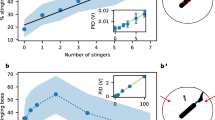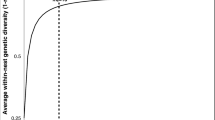Summary
The alarm reaction of groups of honey bee workers was quantified using a metabolic bioassay. The genetic structure of these groups was varied in order to estimate the effects of worker interactions. Though the group phenotype was mainly determined by additive interactions, nonlinear effects were also found. Mixed worker groups, combined from colonies with similar reactivity in the bioassay, showed a stronger response than pure groups. This phenomenon, analogous to the overdominance model for individuals in classical genetics, has implications for mechanisms of natural and artificial selection in social populations and for the evolution of polyandry in social Hymenoptera.
Similar content being viewed by others
References
Buschinger A (1978) Genetisch bedingte Entstehung geflügelter Weibchen bei der sklavenhaltenden Ameise Harpagoxenus sublaevis (Nyl.) (Hym., Form.). Insectes Soc 25:163–172
Chauvin R (1981) La “survivone” substance qui induit le survie des abeilles isolées. Insect Soc 28:218–221
Cole BJ (1983) Multiple mating and the evolution of social behavior in the Hymenoptera. Behav Ecol Sociobiol 12:191–201
Collins AM (1979) Genetics of the response of the honeybee to an alarm chemical, isopentyl acetate. J Apic Res 18:285–291
Collins AM (1982) Behavior genetics of honey bee alarm communication. In: Breed MD, Michener CD, Evans HE (eds) The biology of social insects. Westview Press, Boulder, CO, pp 307–311
Collins AM, Rinderer TE, Harbo JR, Bolton AB (1982) Colony defense by Africanized and European bees. Science 218:72–77
Collins AM, Rinderer TE, Harbo JR, Brown MA (1984) Heritabilities and correlations for several characters of the honey bee. J Hered 75:135–140
Collins AM, Rinderer TE, Tucker KW, Sylvester HA, Lackett JJ (1980) A model of honeybee defensive behavior. J Apic Res 19:224–231
Collins AM, Rothenbuhler WC (1978) Laboratory tests of the response to an alarm chemical, isopentyl acetate, by Apis mellifera. Ann Ent Soc Amer 71:906–909
Craig R, Crozier RH (1978) No evidence for role of heterozygosity in ant caste determination. Isozyme Bull 11:66–67
Crozier RH, Consul PC (1976) Conditions for genetic polymorphism in social Hymenoptera under selection at the colony level. Theor Population Biol 10:1–9
Crozier RH, Page RE (1985) On being the right size: male contributions and multiple mating in social Hymenoptera. Behav Ecol Sociobiol 18:105–115
Falconer SD (1981) Introduction to quantitative genetics. Longmans, London UK
Fischer HE (1978) Heterosis. VEB Gustav Fischer, Jena
Gordon DM (1982) Social context: If ant behavior depends on it, should our methods be leaving it out? In: Breed MD, Michener CD, Evans HE (eds) The biology of social insects. Westview Press, Boulder, CO, pp 396–397
Gordon DM (1983) Dependence of necrophoretic response to oleic acid on social context in the ant Pogonomyrmex badius. J Chem Ecol 9:105–111
Griffing B (1967) Selection in reference to biological groups. I. Individual and group selection applied to populations of unordered groups. Aust J Biol Sci 20:127–139
Griffing B (1982) A theory of natural selection incorporating interaction among individuals. X. Use of groups consisting of a mating pair together with haploid and diploid caste members. J Theor Biol 95:199–223
Kerr WE (1975) Evolution of the population structure in bees. Genetics 79:73–84
Koeniger N (1982) Interactions among the four species of the genus Apis. In: Breed MD, Michener CD, Evans HE (eds) The biology of social insects. Westview Press, Boulder, CO, pp 59–64
Kolmes SA (1985) A quantitative study of the division of labour among worker honey bees. Z Tierpsychol 68:287–302
Lindauer M (1952) Ein Beitrag zur Frage der Arbeitsteilung im Bienenstaat. Z Vergl Physiol 34:299–345
Maschwitz U (1964) Gefahrenalarmstoffe und Gefahrenalarmierung bei sozialen Hymenopteren. Z Vergl Physiol 47:596–655
Moritz RFA (1983) Homogenous mixing of honeybee semen by centrifugation. J Apic Res 22:249–255
Moritz RFA (1986) Estimating genetic variance of group characters: Social behavior in honey bees (Apis mellifera L.). Theor Appl Genet 72:513–517
Moritz RFA, Bürgin H (1987) Group response to alarm pheromones in social wasps (Vespidae). Ethology (in press)
Moritz RFA, Hillesheim E (1985) Inheritance of dominance in honey bees (Apis mellifera capensis Esch.). Behav Ecol Sociobiol 17:87–89
Moritz RFA, Southwick EE, Breh M (1985) A metabolic test for the quantitative analysis of alarm behavior in the honey bee (Apis mellifera L.). J Exp Zool 235:1–5
Moritz RFA, Southwick EE, Harbo JR (1986) Genetic analysis of defensive behaviour of honeybees (Apis mellifera L.) in a field test. Apidologie 18(1) (in press)
Oster GF, Wilson EO (1978) Caste and ecology in the social insects. Princeton University Press, Princeton
Rinderer TE (1982) Genetics of defensive behavior in honey bees (Apis mellifera L.). In: Jaisson P (ed) Social insects in the tropics. Presses de l'Université Paris XII, Paris, Vol 1, pp 249–254
Rinderer TE, Collins AM, Brown MA (1983) Heritabilities and correlations of the honey bee: Response to Nosema apis, longevity and alarm response to isopentyl acetate. Apidologie 14:79–85
Rösch GA (1925) Untersuchungen über die Arbeitsteilung im Bienenstaat. 1. Die Tätigkeiten im normalen Bienenstaat und ihre Beziehungen zum Alter der Arbeitsbienen. Z Vergl Physiol 2:571–631
Rösch GA (1927) Über die Bautätigkeit im Bienenvolk und das Alter der Baubienen. Weiterer Beitrag zur Frage nach der Arbeitsteilung im Bienenstaat. Z Vergl Physiol 6:265–298
Rösch GA (1930) Untersuchungen über die Arbeitsteilung im Bienenstaat. II. Die Tätigkeiten der Arbeitsbienen unter experimentell veränderten Bedingungen. Z Vergl Physiol 12:1–71
Seeley TD (1982) Adaptive significance of the age polyethism schedule in honeybee colonies. Behav Ecol Sociobiol 11:287–293
Sitbon G (1967) L'effet de groupe et la mortalité des abeilles isolées ou groupées. Ann Abeille 10:67–82
Sitbon G (1971) Corpora allata, neurosecretion et effet de groupe chez l'abeille d'hiver. Insect Soc 18:161–172
Southwick EE, Moritz RFA (1985) Metabolic response to alarm pheromone in honeybees. J Insect Physiol 31:389–392
Stort AC (1974) Genetic study of aggressiveness of two subspecies of Apis mellifera in Brazil. 1. Some tests to measure aggressiveness. J Apic Res 13:33–38
Taber S (1985) Bee behavior. Am Bee J 125:432–434
Williams RMC, Perez-Morales JV (1983) The effect of group size on the survival and feeding economy of pseudo workers of building damaging Cryptotermes spp. (Isoptera, Kalotermitidae). In: Jaisson P (ed) Social insects in the tropics. Presses de l'Université Paris XII, Paris, Vol 2, pp 219–234
Wilson EO (1971) The insect societies. Harvard University Press, Cambridge, MA
Author information
Authors and Affiliations
Rights and permissions
About this article
Cite this article
Moritz, R.F.A., Southwick, E.E. Phenotype interactions in group behavior of honey bee workers (Apis mellifera L.). Behav Ecol Sociobiol 21, 53–57 (1987). https://doi.org/10.1007/BF00324435
Received:
Accepted:
Issue Date:
DOI: https://doi.org/10.1007/BF00324435




